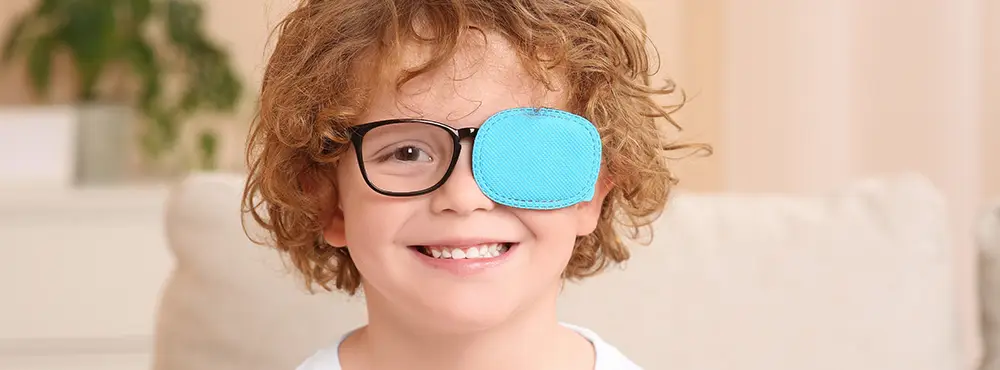What is amblyopia?
Amblyopia (also more commonly referred to as ‘lazy eye syndrome’) occurs when the brain cannot process incoming information from one eye and as time goes on, starts to favour the other eye. As a result, the low functioning eye suffers a decrease in visual acuity.
Amblyopia is the most common cause of decreased vision in one eye in both young adults and children. However, it is known to only affect a very small percentage of adults. If left untreated during childhood, the eye’s central vision may never reach normal levels.
What causes amblyopia?
Amblyopia is often the result of another underlying eye condition. It may not always be clear as to what triggered the condition. There are three main conditions that are known to lead to amblyopia:
Cataracts
Cataracts mainly affect older people but can sometimes affect children as well, this is known as congenital cataracts. Cataracts cause cloudiness in the eye due to a white, milky-looking protein growth that isn’t necessarily painful. However, it can affect vision, causing it to become blurry.
Strabismus
Those with this strabismus (also known as squint) will experience that the eyes will move involuntarily out of sync and not together as they usually should.
Refractive errors
Common refractive errors such as myopia (short-sightedness), hyperopia (far-sightedness) and astigmatism. These eye conditions are easily fixed with contact lenses, glasses or Lasik eye surgery. One eye is usually more visually impaired with the refractive error, causing the other eye to become more dominant.
Amblyopia symptoms
Many people who suffer from the condition may not realise they have it initially (particularly if it is a very mild form) until they are properly tested and diagnosed.
Those with amblyopia may experience:
- A reduction in visual clarity
- Low sensitivity to contrast and motion
- Contrast sensitivity function
- Binocular abnormalities such as impaired stereoacuity (stereoscopic acuity) and abnormal binocular summation
Children with the condition may exhibit the following behaviour if they are suffering from lazy eye:
- Regularly shutting one eye
- Squinting or appearing as if they are straining to see
- Tilting or rotating the head to one side
What causes amblyopia in toddlers and babies?
There are some babies and toddlers that are more likely to develop amblyopia:
- Babies and children who are born with or have developmental disabilities
- Babies who were born prematurely or were smaller than average at birth
- Children whose families have a history of amblyopia or other eye-related health issues like childhood cataracts
How do you prevent amblyopia?
Lazy eye can be detected very early during an eye test, well before the child or parent even knows there is a problem. This is why regular eye tests are important during early childhood development. Babies receive eye tests soon after birth and during regular intervals during their first few years of life. Parents must ensure their child is receiving regular check-ups.
They should also watch out for common signs of lazy eye in their child. These will include those that are mentioned above, as well as:
- An unintentionally wandering eye that wonders inwards and outwards
- Eyes that do not move in unison
- Lack of depth perception
- Unusual results on vision screening tests
Is a child with amblyopia blind?
An eye affected by amblyopia is not considered blind as it is not entirely without sight. The condition mainly affects the central vision of the eye. If a child has amblyopia, their peripheral (side-vision) will usually remain the same.
How is amblyopia treated?
There are two primary methods for treating amblyopia:
- Strengthening the weaker eye by encouraging it to be used more
- Treating underlying eye problems
Corrective lenses
Glasses can correct refractive errors such as short-sightedness, long-sightedness and astigmatism. They may also be used to straighten up a person’s squint. Contact lenses are also an option, but they may not be suitable for younger children who will need supervision whilst wearing them or until they are old enough to wear lenses.
Surgery
If the condition is being caused by cataracts, it will require surgery. Cataract surgery for children usually takes around 1-2 hours and is performed under general anaesthetic.
Strengthening the lazy eye
Wearing a dark patch over the stronger eye will help to encourage more use of the lazy eye. The child will have to wear the patch for several hours a day, usually for several months. This can initially be uncomfortable for the child as you are asking them to primarily use their weaker eye. Encourage them and explain the reasons and rewards for wearing the patch.
Eyedrops
Atropine eye drops are sometimes used to blur the vision of the stronger eye. The drops work by dilating the pupil of the strong eye, encouraging the weaker eye to do more work. Atropine eye drops are often a better option for children who feel self-conscious wearing a patch. However, side effects of atropine eye drops can include headaches, redness of the skin and eye irritation - although these are incredibly rare.
Quick links:
How can I tell if my child has vision problems?
The ultimate guide to astigmatism
What is myopia?
Disclaimer: The advice in this article is for informational purposes only and does not replace medical care or an in-person check-up. Please check with an eyecare professional before purchasing any products or remedies. For information on our article review process, please refer to our Editorial Policy.

 Offers
Offers Account
Account
 Favorite
Favorite
 Basket
Basket

 OFFERS
OFFERS















